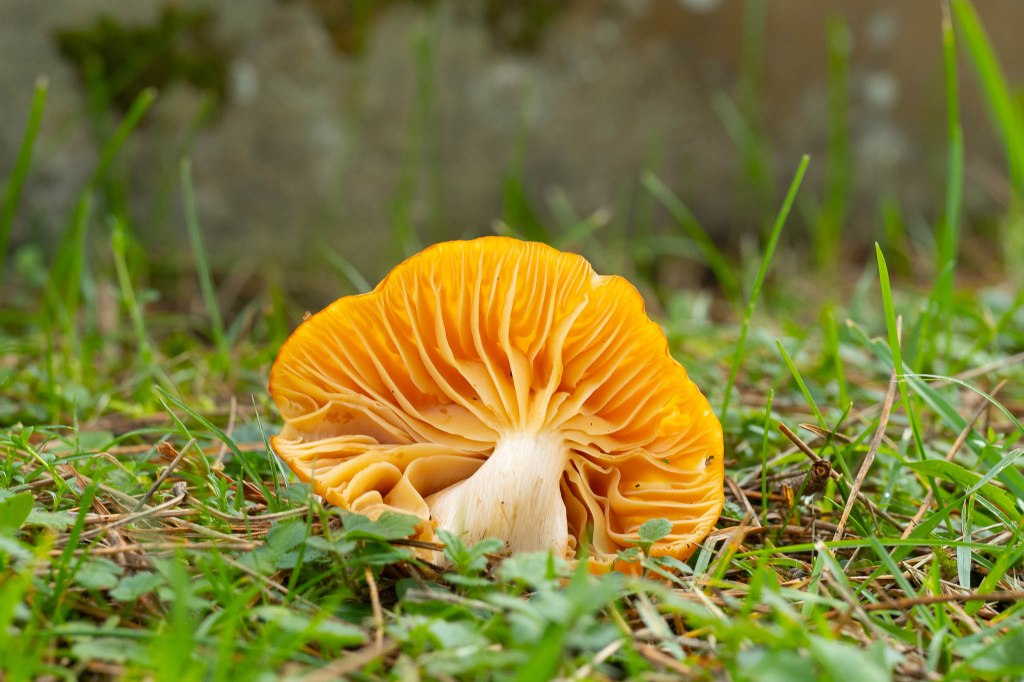
Fungi Friday 4th December 2020
In Sussex we have now inched out of a national ‘lockdown’ and into more localised restrictions on hugs, walks and purchases. Not that fungi (if it could) cares a jot about any of these psychological blockades. They have enough on their hyphae feeding the world’s woods, trees and forests. I will admit that after seeing the mushrooms fading away into a typical ‘mush’ in my local woods (not actually mine) I had sweated on this post. Again, not literally. Temperatures are loitering around the five degrees Celsius mark (I learned this week that Celsius was an actual person) which means frost and therefore frozen fungi. Fungi are 90% water which means they can only really produce fruiting bodies above ground – it can be quite toasty in the soil, where they can remain active socialising with tree roots – when it’s warmer than this.

One thing I have noticed is that fungi are lingering longer in grasslands. Last week I saw inkcaps in golfing greens. Recently I passed a local cemetery and spotted some white mushrooms in the grasslands. On closer inspection I could see these were a white species of waxcap. Waxcaps are rare mushrooms which are largely dependent on ancient grasslands or those which are stable, i.e. not regularly ploughed up or disturbed. Among the white mushrooms I saw some stonking red ones – which iNaturalist helped me to ID as scarlet waxcap. I am put off identifying this family of shrooms because it is not always straightforward, a bit like webcaps, of which there are thousands of species, even in the nature-depleted UK.

These are gorgeous mushrooms. Cemeteries are a great place to find these fungi because the grasslands are sometimes as old as 300 years or more, do not suffer from the use of chemicals, and the lack of footfall out of respect, means the grasslands are soft and accommodating to species trying to move through them. There are lots of projects to monitor grasslands for waxcaps, such as this project from Plantlife and the very interesting charity Caring for God’s Acre.

My best find was this keeled-over meadow waxcap, fanning its gills like some feral peacock. It may have been the frost that has caused it to pose like an ancient tree, but it will probably help with the spread of its spores.

As you can see, waxcaps are incredibly beautiful fungi. If you see any on your travels please do submit species records to Plantlife or your local Wildlife Trust. You can also take a photo and submit it to iNaturalist or iRecord depending on your preference. Better still, inform the people who own the land – ‘do you know you have rare wildlife living on your land?’ – and ask them to take this into consideration when managing it.

Here’s a wider view where you can see just how big the meadow waxcap is! Those surrounding trees will not be great for the waxcaps due to shading, so for their benefit tree planting should be avoided and cutting of the grasslands is a priority.

It wasn’t just waxcaps though, I found something more suitably Gothic growing alongside a grave.

This is a species in a group known as the goblets! What a great name. I need to get myself a goblet.
Thanks for reading.

Thanks. I didn’t know that about fungi and churchyards. Well managed churchyards that are not strimmed again and again probably….
Thanks Anne. Interestingly strimming has a role to play because it keeps the grasslands open, then again people never rake it off afterwards. Grazing is probably best but yeah, not something you see very often in a cemetery!
[…] #FungiFriday: a grave situation — Daniel Greenwood […]
The goblet is something that I haven’t seen before in a graveyard but I have seen and photographed many weird and wonderful looking shrooms . Is there a way I could send some if my pics to you for identification purposes? I recently took a photo of one that can only be described as a fried egg lookalike, I’m sure you’ll have seen this before can you tell me what it is , thank you in advance
Hi Gerry, thanks for your comment! That fungus sounds intriguing. You can send pics to djgwild@outlook.com
There is also iNaturalist which is great: https://www.inaturalist.org/
Daniel
Wow what amazing colours, life, hidden among the stones! I didn’t know about the Waxcap Watch project. Ive credited you in my post, to show your post introduced me to it. I hope that’s okay? If you want me to remove the link, give us a shout, it’s no bother! But credit where credit due. I don’t know for sure if my finds are Waxcaps, as I’m a beginner. Do you know if any other shrooms similar in waxy texture that could be confused?
Hi Leanne, of course that’s ok! Thanks for reading the post and very pleased you liked it and took something away. You are literally saying this on a day that the Guardian used one of my photos without credit, where credit is most definitely due! 😂
As I said in my comment on your article, these are deffo waxcaps and look like parrot waxcaps to me. Grassland may be very old and mowing has kept the shrooms in fruit. I would recommend iNaturalist to check up on these things. Great tool and resource.
Daniel
Oh that’s cheeky of the Guardian!
I wondered if it was a parrot waxcap. I’m going to dare a bit more to share my ID ideas, and let go of that perfectionism. A good idea, to use iNaturalist. Thank you.
Ah that’s interesting, about mowing actually benefiting them!
Happy new year, i hope you get more Fungi Fridays in your 2022 👍